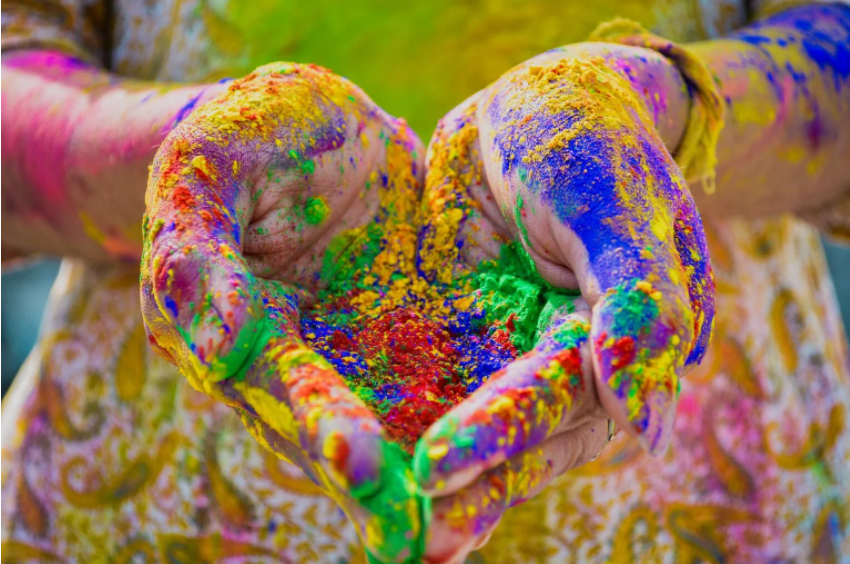~ B. Sujitha
Holi festival is one of the prominent festivals in India. This festival is celebrated all across the country. Holi knows no religious distinctions. It is loved and celebrated by all people, irrespective of differences in religion, region, ethnicity etc. What makes this festival so vibrant and loved by all? The very fact that this is celebrated by everybody with no barriers is the primary reason. The playfulness that encompasses the festival is also special.
Holi festival is known with different names. It is called the festival of colours, the festival of spring, the festival of love etc. It is celebrated on the last full moon day of the lunar month, Phalguna. This day generally comes around the end of March.
What does the festival symbolise:
Apart from all the playfulness and joyous vibrancy of the festival, it also contains a significant cultural and religious significance. It is celebrated symbolising the triumph of good over evil. It is celebrated to welcome spring, after a long winter. With celebrating Holi, people lay the hope for a new start and realising fresh goals and ambitions.
Why are colours used:
Colours are embedded with rich symbolism. They signify vibrancy and completeness. They also embody multiple meanings. Earlier, Holi colours used to be made from flowers of Tesu or Palash tree also called Gulal. They are considered good for the skin with no harmful chemicals.
Legends behind the festival:
Festivals that are celebrated today can be traced back to myths and tales from religious epics like Ramayana and Mahabharata. Some of the stories on the origin of Holi festival are-
There is a king called Hiranyakashipu who once ruled India. He was a staunch opposer of Lord Vishnu. But his son Prahalad was a strong devotee of Lord Vishnu. Hiranyakashipu tried in many ways to wean away from that devotion from his son. Vexed that he was unable to dismantle the devotion, he sought his sister’s help. Her name is Holika. She has magical fire properties i.e., she will not die even if she immolates herself. By using her fire powers she expected to scare Prahalad and make him shed his devotion. But when she immolated herself with Prahalad on her lap, it was she who burned out and died. Prahalad came out of the fire because of his devotion towards Lord Vishnu. This devotion saved him. The day of death of Holika is celebrated as Holi.
Another tale links Holi celebration with Lord Krishna and Radha. Lord Krishna drinks poison given to him by a demon. After drinking that poison, his body turns to blue colour. He becomes doubtful whether Radha, who is fair-skinned will love him or not. But Radha, out of immense love for Lord Krishna, will allow herself to be smeared with blue colour. This story says why the Holi festival is called the festival of love.
Where is the festival celebrated:
It is celebrated across all parts of India, both in rural and urban areas. Different parts of the country celebrate the festival differently. This is because of different historical origins that are associated with the festival. But the use of colours in celebrating the festival gives it an air of oneness. Who can miss out on the cheer that colours give!!
Not only in India, but this festival is also significant in Nepal. Indian immigrants are everywhere in the world. Holi is celebrated in those countries too, which have significant Indian diaspora like the United States of America, the United Kingdom etc.
Rituals on Holi Day:
Rituals that are done on the Holi festival day also vary across the country. The festival was originally a ceremony of married women. It was celebrated by married women to spread positivity. Later, it was evolved to include all and became all-encompassing.
In some parts, the festival commences with Holika Dahan, the burning of an effigy of Holika. Holika Dahan symbolises the destruction of inner evil. In West Bengal and Assam, Holi is known as Basant Utsav ( Spring Festival). In Uttar Pradesh, in a town called Barsana, Lathmar Holi is celebrated. Lathmar Holi is a fun-filled celebration of Holi, where women beat up men with sticks. In Maharashtra, Holi is celebrated with the Matki Pod ritual. Matki Pod means breaking the pot. Men form a human pyramid and break the pot.
Why is it abhorred by few at present:
The festival has a noble rationale. But with time, the celebration of the Holi festival has attracted criticisms. Shifting from the usage of natural colours to chemical colours. These colours are dangerous for both human skin and the environment. Commotion generated while celebrating the festival has been causing disturbance to the civilian population. It generates a lot of noise pollution. The Holi festival is celebrated with a lot of crowds. Inappropriate behaviour with women during the festive has made people severely critical of the festival.
However, the auspicious spirit still lieswithin people. Thus, people have only become more cautious while maintaining the love for the festival. Even after this change through the generations, people still relate Holi with good over evil, positivity over negativity and happiness over sorrows. .
The first thought that comes to our mind when we hear the name ” Holi Hai “, is joy, love, cheer and colours. After all, it is a festival of embracing joy and happiness.
So let’s make this Holi memorable and feel the brightness of the colours filling in beautiful colours into our lives. Happy Holi to all !!!
Must Read: WORLD SACRED SPIRIT FESTIVAL






2 Responses
Such a great details to review. I love the method you write.
Perfect!
Hi, Thank you very much for going through our blogs. It’s a pleasure to give voice to the facts and opinions for you all to read. Keep encouraging us by staying tuned to our posts and with your lovely comments.
Thanks a lot!